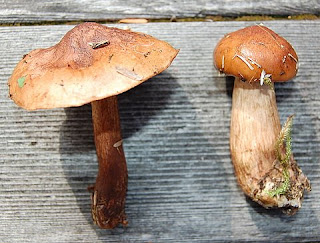
I did a quick collecting run Saturday evening through the Historical park and by the SJ lawn. I brought one quart sized ziploc bag which was happily inadequate for what I found on my pre-dinner run. In fact I had the bag over full to spilling and three large Hydnum repandums in my hand by the time I was back to the parking lot. In the park the Amanita muscaria are coming on nicely, there were several very small golden chanterelles and troops of Winter ones. Clitopilus under the spruce by the corner of the lower parking lot. Collected a deep red peppery Russula with yellow spores that I'll call R. queltiii. Also saw Clavaria purpurea, Cortinarius semi-sanguinarius and Entoloma stritus.

I did collect a few new things on the path home including Agaricus smithii.
I haven't found too many Agaricus in southeast outside the grocery store, so I was kind of excited to hear about one growing near the large spruce in the SJ lawn. There were 3 or 4 large mushrooms growing in grass and another one coming up. None of them were fully open, so I'm unsure how large this one can be. I did leave one to grow and am optimistic that it might be allowed to grow (I'm deluding myself on this one). The two individuals I brought home were about 4 inches tall, the stems were rather stout (ca. an inch in diameter) with a larger base. The cap and stem have kind of a golden cast to them that increased with age. The flesh or surface didn't show any staining. There wasn't a distinctive odor to me. It is supposed to have an almond odor, but it isn't apparent to my weak nose. The ring is membranous, but difficult to see with the cap unexpanded. The base of the stem was large enough to key this one to A. smithii.
Tricholoma pessundatum: The Tricholoma was growing under Western Hemlock in moss under Sitka spruce beside the path to the plaque on Merrill Rock. I collected several as the fruiting bodies were rather abundant.
The cap was medium red Brown (#43) with darker small fibrils. The caps were somewhat viscid. The margin is blackened in the older individuals. The photo looks a little oranger than the mushroom in hand. The mature caps I measured were 65cm, 54, 52, and 50cm in diameter. The young caps are reminiscent of the shape of a Russula. The gills are white with brown stains or flecks. The stem is light brown with darker lengthwise lines, kind of fibrous looking.
It took a couple of trys to identify this one. It keyed to Tricholoma stans in the PNW key, mostly because I bypassed T. pessundtum because the gill margins didn't have the dark edge. T. stans isn't documented in the PNW or in California, so I was feeling a bit dubious. In the key to Tricholoma at the Mushroom expert site, it keyed to T. pessundtum which is documented in the PNW. Arora says that it should be avoided unless one wants to spend the night violently ill. I'm content to eat king boletes and hedgehogs.

The last one didn't come from the park but was a left over from the insect collecting earlier in the week. It was growing on the ground in the young growth forest (Pine, Hemlock, Spruce etc) off the lower trail of Gavan Trail.
Cordyceps is an obligate parasite of either arthropods or other fungi, in the case of C. ophioglossoides of an Elaphomyces (deer truffle). Unfortunately, I didn't dig down far enough to see if there was a truffle below. Seems like I'm not the first person to pick this fungus without adequate digging.
Despite all of the emphasis on fungi and the required focus on the ground to find them, I have noticed a few birds lately. There are 6 nuthatches, chickadees, juncos and song sparrows working the feeder. One Golden-crowned sparrow was in the garden on Saturday. One day last week there were about 20 Black-legged Kittiwakes on the path to town. Friday I saw one Phalarope on the way to town and Fork-tailed Storm petrels on the way home. They were there on Saturday and today as well.


4 comments:
Awesome site, I had not come across naturalhistorysitka.blogspot.com earlier during my searches!
Carry on the wonderful work!
Hello there,
Thanks for sharing the link - but unfortunately it seems to be down? Does anybody here at naturalhistorysitka.blogspot.com have a mirror or another source?
Cheers,
Peter
I'm assuming you are referring to the Cordyceps link. I just checked the link and it seemed to work for me. I'll do a bit more digging and see what the problem could be.
thanks for letting me know
Hi - I am certainly happy to discover this. cool job!
Post a Comment